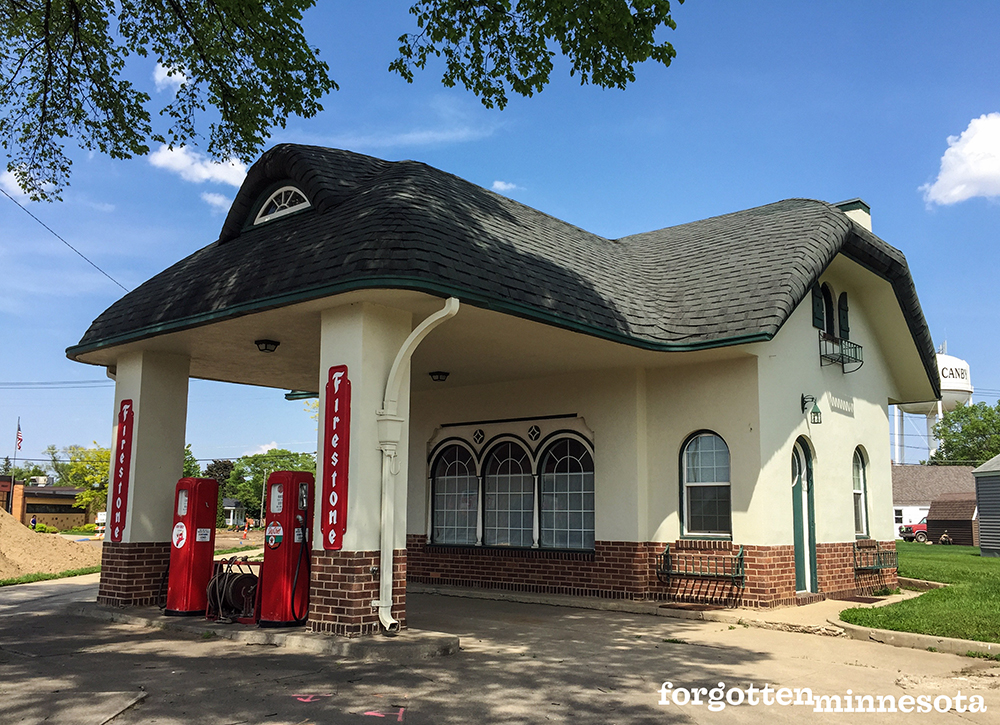Lundring Service Station in Canby
As the popularity and accessibility of automobiles grew throughout the 1920s and 1930s, the problem of finding the right place to put filling and service stations became a concern for residents and city officials. Filling stations in the mid-1910s were merely curbside gas pumps connected to an underground tank. The pumps were designed to fill a tin can, which would then be taken home and stored in the garage until it was needed. Although this option was more convenient than having to visit a wholesale gasoline seller, which were often only located in large cities, refineries were looking for new ways to make purchasing gasoline even more convenient for automobile owners. They wanted to bring pumps closer to residential areas and eliminate the need for customers to store gasoline in their garage, thereby reducing the risk of the tin containers catching fire and putting homes in jeopardy.





Communities understandably didn’t want unsightly gasoline pumps located close to residential neighborhoods, so oil companies looked for more attractive ways to bring their product closer to customers. Their first offering was known as the shed design. As the name implies, sheds would be built on corner lots with gravel or dirt driveways leading to the pump. The small, utilitarian building was used to house equipment, oils, and greases needed for early cars. A gasoline pump would be located in the front or at the side of the building. They were nothing more than practical and their appearance, along with the smell and clutter that typically surrounded them, often drew complaints from neighbors.
The next evolution of the service station became one of the most popular. Known as the house or cottage design, these stations blended into business districts and the fringes of residential neighborhoods. Exterior design styles varied, but most of the service station interiors were similar. They contained small offices, a couple of small storage rooms, and restrooms for the public. The entrance to the men’s restroom was located inside, and an exterior entrance to the ladies room was typically located at the back of the station. Hand-cranked oil dispensers were installed at the center of the main shop, along with a few chairs and a stove for heat.








Many of the house and cottage style service stations were prefabricated. Oil companies could select one of the several standardized building plans, or custom design a building for that company’s exclusive use. Pure Oil was the first to adopt an English cottage look with white stucco exteriors and steep, end-gabled roofs tiled in blue. Phillips 66 and Sinclair also adopted the English cottage look. Standard Oil and Beacon Refining Company preferred a colonial design with brick exteriors and stately columns. A simpler, but highly-recognizable custom brick and tiled roof motif was chosen by Gulf Refining Company, while Ventura Refining Company and Texaco both assumed a Spanish Mission style for their stations. Each of these styles could be seen throughout Minnesota.
One of the most charming examples of the English cottage-style service station can be found in Canby. Oscar Lundring independently owned and operated the Sinclair Oil Company service station at the corner of First Street and Oscar Avenue. Built in 1926, the station was a departure from typical Sinclair stations that featured a brick exterior, steeply-pitched gable roof, and no canopies. Lundring’s station was covered in stucco and boasted a low-pitched, jerkinhead gabled roof covered in irregularly cut shingles laid to curve at the eaves and corners to resemble heavy thatching. Decorative elements included an eyebrow dormer with fanlight window, arched windows and doorways, shutters, and window boxes for flowers.




In 1960, a two-bay, flat-roofed addition was constructed at the back of the station for servicing cars. The exterior was covered with stucco to blend with the original portion of the building. Modern pumps were added in the 1950s. The service station was used until the early 1960s. More recently, the 1950-era pumps were replaced by beautifully restored, non-functional, vintage Texaco pumps. Although the subsequent owners have used the station for different purposes, they have retained and maintained the distinctive architecture and interesting character of the service station. Because of this foresight, the Lundring Service Station was placed on the National Register of Historic Places in 1986.
